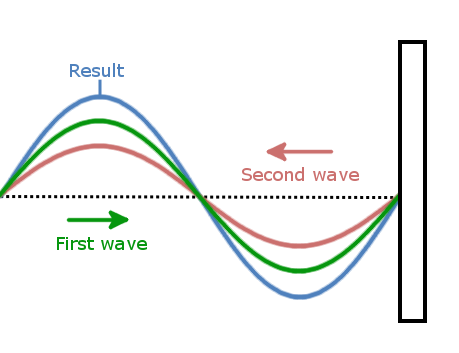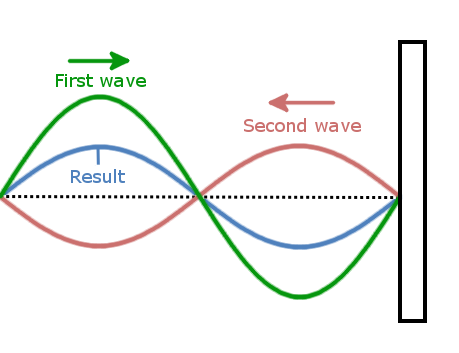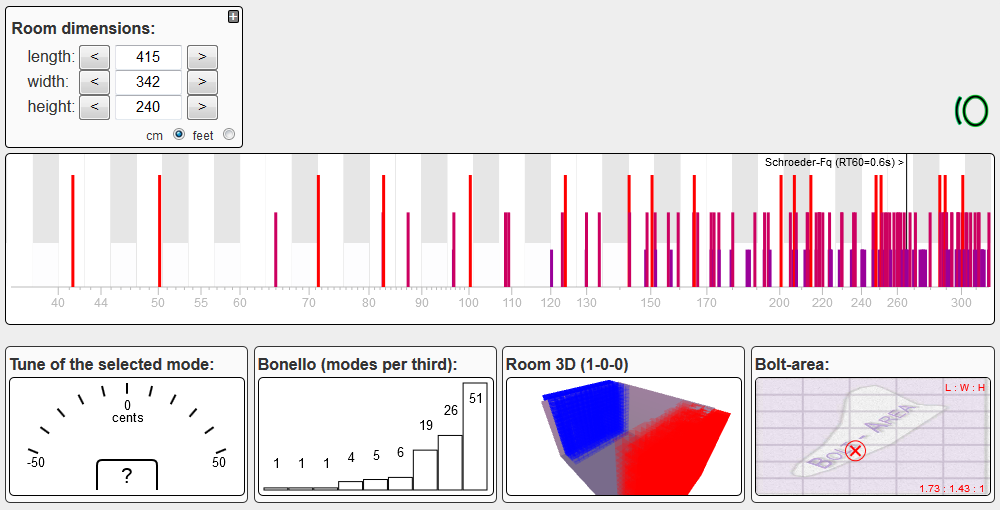Standing waveforms and room modes
If your studio has at least one pair of parallel reflective surfaces and I'll bet it has (the walls or the floor and ceiling), then you can observe a physical effect called standing waves. Standing waves are a big enemy because they distort the bass and lower mid-range frequencies from 300 Hz on down.
Standing waves are created when the sound is reflected back and forth between any two parallel surfaces in your room and the sound wavelength is equal to the dimensions between these parallel walls. They affect frequencies below 300 Hz.



standing wave between two parallel walls - Fundamental frequency and its multiples
You can calculate what is the frequency of the standing wave for your room: f = V / 2d
- V = Velocity of sound (343m/sec)
- d = Room dimension in meters (length, width, or height)
- f = frequency of the standing wave
Other standing waves occur at harmonics of the frequency that is 2, 3, and 4 times the fundamental but obviously, the higher the frequency, the less noticeable they become. If the room has a rectangular shape then it has parallel walls in all three axes (length, width, height) and also three different sets of affected frequencies.
You can hear the effect of the standing wave in your room very easy by yourself. Just measure one of three dimensions of your room between parallel walls, calculate the frequency and use the oscillator in your DAW to produce the sound. Then try to walk through the room, you will hear differences in intensity of the sound in different places. It is caused by interference of the original sound wave and its reflection. I'm sure that you will figure out that the volume may sound twice as loud in some areas as opposed to others.


If you have repeated calculations for all 3 dimensions and you have calculated all three fundamental frequency values then you know the axial room modes of your room. Don't forget that you have to take into account also its multiples and even more, because the sound is not propagated in just three directions we also know other types of room modes - tangential and oblique - these also affect the sound field but have lower level ratios (1/2 and 1/4) in comparison to axial. But don't despair, you don't have to calculate these complicated things, just use one of the room modes calculators on the web.
Let's take my room as an example. The room is 4.15m long, 3.42m wide and 2.40m in height (far away from ideal proportions). You can easily put these values to one of my favourite calculators and you will get all the necessary data and its visualization. Immediately is possible to see which frequencies are that badass and then you can focus on them during sound treatment design and because homemade sound treatment doesn't completely solve all these problems you have to also give them special attention during production - sound design and mix-down process - especially on the bass elements (baseline and kick, but not solely - always are there also other instruments that contains mid-low frequencies).
Now put to the calculator dimensions of your room and from the 3D visualization of the room, you can see which frequencies and which places in the room are most affected - where is the cumulation of sound pressure is most significant. Even more, if you leave the cursor at one of the marked frequencies, the calculator will generate adequate sound and you can walk around your room and hear the changes of sound volume in particular room parts. If you will run with cursor through all frequencies you will notice that all four corners are always most affected - coloured in visualization and it sounds boomier than other places. It means that the most noticeable volume cumulation (sound pressure) is in corners where meets all tree rooms axis. The following are 2 axis corners - joints between floor and wall or ceiling and wall or joint of two walls.
Corners are the most important and best place to apply sound treatment elements to improve the bass response of the room - bass traps or something similar to Helmholtz resonators. In the case the room is small (which always is) and there is one or two most terribly problematic frequencies is the best solution to apply something like the Helmholtz resonator. If problematic frequency belongs to the lows then the wavelength of the sound can be up to several meters long, subsequently is just not possible to apply an acoustic panel with an effective thickness (1 meter for example). Helmholtz resonator is an element with relatively small proportions which can be tuned to absorb a certain frequency even if it's one of the lows with a big length. On other hand a drawback of a simple Helmholtz resonator is bandwidth - the resonator is tuned for certain frequencies and is not able to absorb the others. Still is there an option to use a construction that fuses both principles and use more resonators tuned to different frequencies but as always it's a matter of cost.
In the end, is need to note that sound waves from 40Hz up to 400Hz have lengths from 8.5m down to 0.85m and under small home production or recording studio conditions is impossible to completely treat the room for bottom low frequencies. For total tame, such long waves would need to use absorbers of huge dimensions. In professional studios, it's solved by building construction itself. Usually, the buildings have special construction with doubled walls with adequate space between where are installed another wall with absorptive materials and/or constructions of big hanging traps and/or devices working on the principle of Helmholtz resonator.
Despite the mentioned, I think (and I have it tested by my own ears) that the application of several DIY corner bass traps under home conditions helps, and always is better to do this minimum.
